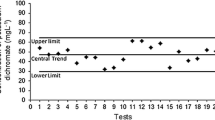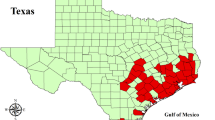Abstract
Captan did not affect the survival of Dungeness crab (Cancer magister Dana) zoea exposed to 30 μg l-1 during a chronic toxicity test lasting 69 days, but larvae were quickly killed (mean survival time = 9 days) in the same test by exposure to 450 μg l-1 of the fungicide. Delay of molting occurred, however, for later stages at 30 μg l-1. Survival of juvenile crabs was not reduced by exposure to captan for 36 days at 510 μg l-1 or, in a second test, for 80 days at 290 μg l-1. No deaths of adults exposed for 75 days to 340 μg l-1 of captan were observed. Captan appeared to accelerate hatching of eggs at all concentrations tested from 100 to 10,000 μg l-1. The development from prezoeae during a 24-h period was not inhibited by the fungicide, but at 3,300 and 10,00 μg l-1, the two highest concentrations tested, developing zoeae exhibited a morphological deformity and were largely inactive. Under the prevailing conditions in the toxicity tests, the half-life of captan was estimated to be from 23 to 54 h. Because of the relatively low toxicity of captan to crab stages and its high rate of degradation in sewater, it is suggested that the agricultural application of captan near marine waters is not likely to affect natural crab populations or crabs in laboratory culture. Further-more, the prophylactic use of captan as a fungicidal treatment for Lagenidium sp. in larval crab cultures is considered safe when used at recommended dosages.
Similar content being viewed by others
Literature Cited
Abedi, Z.H. and W.P. McKinley: Bioassay of captan by zebrafish larvae. Nature, Lond. 216, 1321–1322 (1967)
Armstrong, D.A., D.V. Buchanan and R.S. Caldwell: A mycosis caused by Lagenidium sp. in laboratory-reared larvae of the Dungeness crab, Cancer magister, and possible chemical treatments. J. Invertebr. Path. 28, 329–336 (1976a)
——, M.H. Mallon, R.S. Caldwell and R.E. Millemann: Toxicity of the insecticide methoxychlor to the Dungeness crab Cancer magister. Mar. Biol. 38, 239–252 (1976b)
Bookhout, C.G., A.J. Wilson, Jr., T.W. Duke and J.I. Lowe: Effects of mirex on the larval development of two crabs. Wat. Air Soil Pollut. 1, 165–180 (1972)
Buchanan, D.V. and R.E. Millemann: The prezoeal stage of the Dungeness crab, Cancer magister Dana. Biol. Bull. mar. biol. Lab., Woods Hole 137, 250–255 (1969)
—— and N.E. Stewart: Effects of the insecticide Sevin on various stages of the Dungeness crab, Cancer magister. J. Fish. Res. Bd Can. 27, 93–104 (1970)
—, M.J. Myers and R.S. Caldwell: Improved flowing water apparatus for the culture of brachyuran crab larvae. J. Fish. Res. Bd Can. 32, 1880–1883 (1975)
Calwell, R.S.: Osmotic and ionic regulation in decapod Crustacea exposed to methoxychlor. In: Pollution and physiology of marine organisms, pp 197–223. Ed. by F.J. Vernberg and W.B. Vernberg. New York: Academic Press 1974
Epifanio, C.E.: Effects of dieldrin in seawater on the development of two species of crab larvae, Leptodius floridanus and Panopeus herbstii. Mar. Biol. 11, 356–362 (1971)
Frear, D.E.H. and J.E. Boyd: Use of Daphnia magna for the microbioassay of pesticides. I. Development of standardized techniques for rearing Daphnia and preparation of dosage-mortality curves for pesticides. J. econ. Ent. 60, 1228–1236 (1967)
Hermanutz, R.O., L.H. Mueller and K.D. Kempfert: Captan toxicity to fathead minnows (Pimephales promelas), bluegills (Lepomis machrochirus) and brook trout (Salvelinus fontinalis) J. Fish. Res. Bd Can. 30, 1811–1817 (1973)
Holland, G.A., J.E. Lasater, E.D. Neumann and W.E. Eldridge: Toxic effects of organic and inorganic pollutants on young salmon and trout. Res. Bull. Wash. St. Dep. Fish. 5, 1–264 (1960)
Poole, R.L. and M. Willis: Effects of some pesticides on larvae of the market crab, Cancer magister, and the red crab, Cancer productus, and a bioassay of industrial wastes with crab larvae. Manuscr. Rep. Calif. Dep. Fish Game mar. Resour. Reg. 70–15, 1–19 (1970)
Reed, P.H.: Culture methods and effects of temperature and salinity on survival and growth of Dungeness crab (Cancer magister) larvae in the laboratory. J. Fish. Res. Bd Can. 26, 389–397 (1969)
Author information
Authors and Affiliations
Additional information
Cummunicated by N.D. Holland, La Jolla
Technical Paper No. 4131, Oregon Agricultural Experiment Station.
Rights and permissions
About this article
Cite this article
Caldwell, R.S., Armstrong, D.A., Buchanan, D.V. et al. Toxicity of the fungicide captan to the Dungeness crab Cancer magister . Mar. Biol. 48, 11–17 (1978). https://doi.org/10.1007/BF00390526
Accepted:
Issue Date:
DOI: https://doi.org/10.1007/BF00390526




